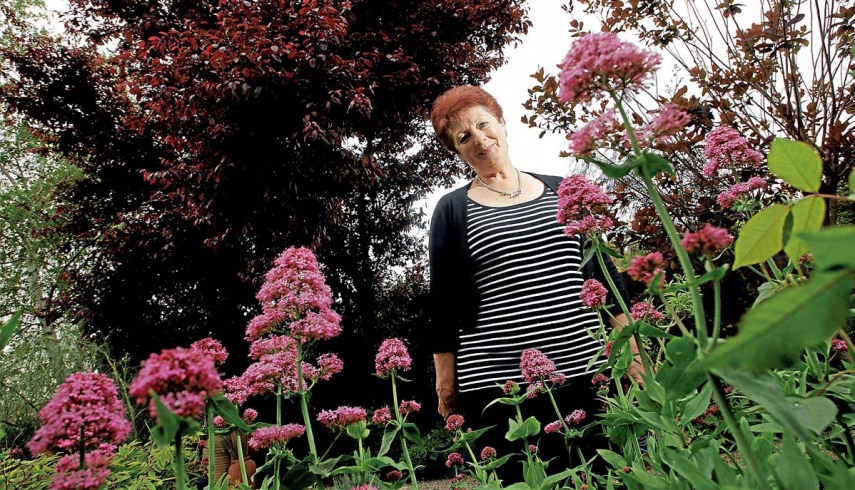For some people, the best thing about maintaining an extravagant garden is sharing it with the public, as ROBERT FEDELE discovers.
LORRAINE Gallagher smiles. “Lucky I weeded here this morning,” the head gardener at historic Overnewton Castle in Keilor says. “I’d be very embarrassed otherwise.”
Overnewton Castle is a wedding and function centre, but once upon a time it was home to Scotsman William Taylor, who set about building a miniature Scottish baronial castle in 1849.
Today it makes for a grand venue with lush surrounds and picturesque plant life.
Gallagher works at the property three days a week, helped for the most part by her trusty right-hand man, Charlie.
Much like her surrounds, she has a rich history of her own, only it’s in horticulture.
She left her home town of Bendigo in her teens and moved to England where she trained in the field in the 1980s.
“If you love horticulture it’s the place to be,” she says fondly.
Gallagher held many high-profile jobs in England, working for bishops and lords and ladies. Her first position as head gardener was for the bishop of St Albans in Hertfordshire.
“I was the head gardener and chauffer,” she recalls with a laugh. “I used to have to drive up to the House of Lords and drop him off and then come back and mix the compost.”
And, reminiscent of that scenario, Gallagher describes gardening as a balancing act.
“I think, in a way, it’s sort of a political game because you’ve got the anarchy of things that grow and then you have to bring your democratic and autocratic spade to bear on things with pruning.
“It’s like controlling, but also letting nature have its way. You’re creating a democracy with nature.”
Gallagher returned to Australia in 2005 and settled in Taggerty, between Marysville and Alexandra, working at the Marylands Country House.
She and her partner were in the thick of the Black Saturday bushfires and were under threat before being spared by a wind change.
“We didn’t know what was happening except by going out and looking and smelling and listening. That’s all we had to go by.
“We heard this roaring sound like the airport here [Keilor]. It was like jets taking off and bombs being dropped.”
Not so fortunate were many friends, or the Marylands Country House, which was destroyed on the night of Black Saturday.
Gallagher had planned to go to work that day but decided against it because of the heat.
Even now, she struggles to talk about the events.
A human life is far more important than a patch of grass but, even so, she still feels for her pride and joy.
“Even now I feel quite emotional about it. I nursed my garden through the drought. People lost family members and colleagues. And I couldn’t really talk about it because it seemed so pathetic to say, actually, I’m grieving for my garden.”
Six months after the horrific events, Gallagher was offered the role at Overnewton Castle, which she jumped at and is continually grateful for.
Earlier this year the venue opened to the public as part of Open Gardens Australia.
Gallagher praises the concept, which coincidentally was pioneered by Betty Jessel back in England at Sandringham Castle, before filtering across the world.
Gallagher worked for Betty’s son Alistair at Ladham House in Kent.
Avondale Heights resident Maureen Scoble has been a keen gardener for decades and now acts as a scout for Open Gardens Australia, specifically in Melbourne’s west.
Established in 1987 as Victoria’s Open Garden Scheme, the not-for-profit organisation opens private gardens and organises garden-themed events for public enjoyment around the country.
The organisation last year was renamed Open Gardens Australia.
About 15 years ago Scoble asked a local nursery if her garden might be good enough to open to the public.
The answer was a resounding ‘yes’ and every year in summer Maureen would open her doors to interested onlookers. Eight years ago she was asked to be a selector and find hidden gems that might be of interest.
“I’m a great walker,” Scoble enthuses. “I walk around the suburbs and if I see gardens that are really good I might chat to the person if they’re out and about, or sometimes I leave a note in the letterbox.”
Scoble’s own garden began in 1985 when she planted a bunch of natives and sat back and watched them grow at a rate of knots.
“For me it wasn’t enough, though,” she says.
“I wanted to actually garden, not just see plants grow. I like native plants and I’ve got them, but native gardens to me don’t look like gardens. People try to make them look like scrub.
“They put in native plants and put down pine bark and a half-rotten log and it’s supposed to look like the bush . . . well it doesn’t. Nature does that much better.”
These days Scoble’s garden has changed tack.
Its focus is drought-tolerant plants and it features her favourite salvias, of which there are 20 or 30 different types.
“I ended up taking out all my lawn because when I was out there with my friends in the summer the lawn always looked terrible. You’re not out there in winter when it looks good, so I thought what’s the point.
“Now it’s all gravel. If I decide I want to move plants to a different area I just dig them up and put some gravel down. It’s a garden that’s changing all the time.”
Scoble works as a nurse at the Royal Children’s Hospital’s paediatric intensive care unit, and gardening offers her a relaxing outlet.
“It’s for me,” she says with a sense of pride. “It’s my garden. My husband paints in his spare time. I don’t paint. He doesn’t garden.”
Scoble says she will most likely never be fully happy with her garden and that’s probably the way it should be.
“It’s never going to be [perfect]. Gardens . . . you put in a plant and it gets too big, or it gets too old, or you plant something else and they don’t look nice together. It’s the nature of the garden to be always changing.”
Husband and wife team John and Corinne Upsher, who live in nearby Maribyrnong, opened up to the public in late October under the garden scheme.
The couple had visited Scoble’s garden a year earlier, before they were invited to take part themselves.
About 200 people trickled through their home over two days, taking in their Australian native garden along the banks of the Maribyrnong River.
The Upshers’ garden is filled with a large collection of eremophilas, fruit trees, vegetables, and ponytail palm and cycads.
“It was rewarding,” says John Upsher, of seeing people smile at his hard work.
“The open garden weekend was very heartwarming for us. We were overwhelmed by the intensity of the interest people showed and how impressed they were.”
The Upshers have lived in Maribyrnong since 1972 and their garden is forever changing.
The only thing that remains from the original is a plum tree.
The couple joined the Australian Plants Society Keilor Plains Group 10 years ago and it further boosted their interest in Australian native plants, which have become the garden’s signature.
Most of the native trees and shrubs have been grown from seeds or cuttings.
Upsher says his fascination with Australian natives is due to them needing little water and fertiliser and just a bit of pruning. “Our garden’s always changing, but we don’t have any major plans to change anything.”
Hobsons Bay Altona Garden Club president Valda Graham became interested in gardening 15 years ago.
“I’m the president,” she points out proudly.
“Quite a few of my friends were going [to the club] and when I retired I joined them.”
The club has about 70 members and meets monthly at the Youth Hall in Altona.
The meeting doubles as a chance to trade plants with fellow gardeners.
And Graham says it’s also a good social outlet.
“You meet up with all the oldies, of whom I’m one,” she says with a smile. “A lot of them really look forward to it.”
Graham’s back garden is vibrant and colourful. She likes sweet peas and her husband likes roses.
She’s had a knee reconstruction, which has affected her mobility slightly — but nothing a few raised garden beds couldn’t fix.
“Now I can go out and sit on the side and weed and enjoy the garden.”
Scoble is still on the hunt for the next ‘hidden’ garden that might make the grade next year.
She says gardening has been predominantly the domain of the older generation, but things are changing. “I think young people are very much into sustainable gardening. They’re interested in growing their own vegetables and things. And that will be a stepping stone to becoming gardeners.”
For more information on Open Gardens
Australia, visit: opengarden.org.au








